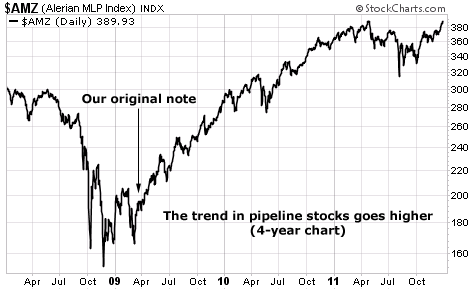| Home | About Us | Resources | Archive | Free Reports | Market Window |
Don't Fall For This: "It's Down So Much... I Can't Go Wrong"By
Tuesday, January 3, 2012
I hope you don't fail my basic "Financial IQ Test."
Unfortunately, most people do.
It's just one question. And it's incredibly simple to understand. It should be incredibly simple to change, too.
Let me explain...
When I started out in 1993 as a stockbroker, I quickly learned that customers loved to "bottom fish."
Doctors and lawyers didn't want to buy the ideas I recommended... They wanted to buy stocks that had fallen a lot in price. "It's down so much, I can't go wrong," they'd say.
These customers had no idea what a horrible strategy that was... And at the time, I didn't have any statistical proof of how bad the idea was. All I knew is that it didn't work – I saw that firsthand.
But today, I have the proof for you... And it is undeniable.
"If you're looking for a great way to underperform the market, look no further," James O'Shaughnessy writes in his excellent book, What Works on Wall Street.
O'Shaughnessy sliced and diced the stock market in his book, sizing up nearly every possible way to make money in stocks – usually going back over 80 years. And he found that buying what has fallen the most is one of the worst strategies. O'Shaughnessy's conclusion is:
"Unless FINANCIAL RUIN is your goal, avoid the biggest losers."
Here's what O'Shaughnessy did:
He put all stocks into 10 different groups, based on their trailing six-month performance. The top-performing 10% of stocks over the previous six months was Group One, and the bottom 10% of performers was Group Ten.
Here's what he found:
Which would you prefer? More than $572 million? Or less than $300,000?
If you'd bought the winners over the preceding six months (the top 10% of performers), you'd have made more than half a billion dollars.
If you'd "bottom-fished" and bought the losers over the last six months (the bottom 10% of performers), you'd have made about 0.05% as much.
In short, you'd have made a fortune doing the opposite of what the doctors and lawyers did.
Longtime DailyWealth readers know I like buying what's cheap and hated. But you also know I wait for an uptrend. I believe it's the most important part of the picture. And O'Shaughnessy proved it.
His study shows that buying what was already "up" proved incredibly successful...
"Over six-month and 12-month periods, winners generally continue to win and losers general continue to lose," O'Shaughnessy writes.
The results by group form an almost perfect "stair-step" downward... Group One compounded your wealth at 14% a year. And Group Ten compounded your wealth at 4% a year. ("Buy and hold" for all stocks was 10% a year.)
Whenever I hear an investor say his main strategy is to buy what has fallen a lot recently, he fails this Financial IQ Test. This person has just proven he has no idea what actually works.
All I'm concerned about is what actually works. And what works is buying what was up, not down. Simply buying what was up over the previous six months turned $10,000 into over $500 million. Doing the opposite performed far worse than the stock market (with much more volatility, too).
Please don't trade like my old doctor and lawyer customers. Don't fail this Financial IQ Test. Don't buy what's down as a strategy. It not only doesn't work... it fails miserably.
Don't go shopping for "deals" in what's fallen the most over the last six to 12 months. The historical record is painful. It doesn't work. Instead, do the opposite.
Do what works... History shows you'll be well-rewarded if you do.
Good investing,
Steve
Further Reading:
Here are a few more of our favorite books on wealth and investing...
If you see any of these books in second-hand bookshops, buy them immediately. You'll never look at your investments the same way again...
"It's sort of a collection of fables for the 21st century. They show you how to lead a fulfilling and wealthy life," Tom Dyson says.
"We have spent lots of time with many hugely rich entrepreneurs," Steve says. "We have heard the stories of how they got to where they are now. No book we're aware of captures those insights as well as this one..."
Market NotesTHE BREAKOUT IN PIPELINE STOCKS The business of transporting and storing energy starts 2012 with the trend in its favor...
Back in early 2009 – near the bottom of the great credit crash – we noted how income-seeking investors should consider a position in "MLPs," short for "Master Limited Partnerships." This sector consists of firms that own and operate energy transportation assets like pipelines. To entice people to invest in America's energy infrastructure, the government has granted MLPs special tax breaks, which require them to pay out most of their income to investors.
In our original note, we pointed out how this beaten-up sector was offering 10% yields. We updated you on this big trend over the next year here and here. And as you can see from today's chart, this trend is still going strong.
Our chart plots the price performance of the benchmark Alerian MLP Index. As you can see, this index crashed along with everything else in late 2008. It then formed a bottom and staged a big "bad to less bad rebound" to double in value. The index moved sideways in 2011 to digest those gains. But in just the past few months, it has "broken out" to a new multi-year high. Yielding around 6% on average, MLPs aren't the bargain they were in 2009. But low natural gas prices mean plenty of demand for these "energy toll roads"... And the trend is still up.
 |
Recent Articles
|


